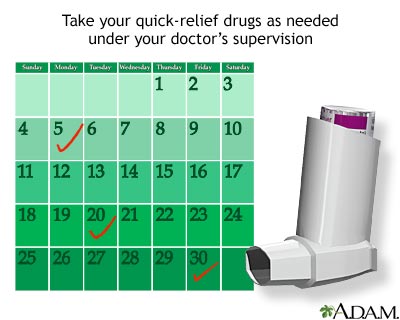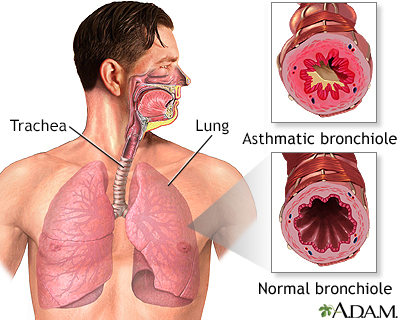Asthma - quick-relief drugs
Asthma - quick-relief drugs - short-acting beta-agonists; Asthma - quick-relief drugs - bronchodilators; Asthma - quick-relief drugs - oral steroids; Asthma - rescue drugs; Bronchial asthma - quick relief; Reactive airway disease - quick relief; Exercise-induced asthma - quick relief
Images



I Would Like to Learn About:
Description
Asthma quick-relief medicines work fast to control asthma symptoms. You take them when you are coughing, wheezing, having trouble breathing, or having an asthma attack. They are also called rescue medicines.
Many of these medicines are called "bronchodilators" because they open (dilate) and help relax the muscles of your airways (bronchi).
You and your health care provider can make a plan for the quick-relief medicines that work for you. This plan will include when you should take them and how much you should take.
Plan ahead. Make sure you do not run out. Bring enough medicine with you when you travel.
Short-acting Beta-agonists
Short-acting beta-agonists are the most common quick-relief medicines for treating asthma attacks and are considered to be bronchodilators.
They can be used just before exercising to help prevent asthma symptoms caused by exercise. They work by relaxing the muscles of your airways, and this lets you breathe better during an attack.
Tell your provider if you are using quick-relief medicines twice a week or more to control your asthma symptoms. Your asthma may not be under control, and your provider may need to change your dose of daily control medicines.
Some quick-relief asthma medicines include:
- Albuterol (ProAir HFA, Proventil HFA, Ventolin HFA)
- Levalbuterol (Xopenex HFA)
- Metaproterenol
- Terbutaline
Short-acting beta-agonists may cause these side effects:
- Anxiety.
- Fast and irregular heartbeats. Call your provider right away if you have this side effect.
- Headache.
- Restlessness.
- Tremor (your hand or another part of your body may shake).
Oral Steroids
Your provider might prescribe oral steroids when you have an asthma attack that is not going away. These are medicines that you take by mouth as pills, capsules, or liquids.
Oral steroids are not quick-relief medicines but are often given for 7 to 14 days when your symptoms flare-up.
Oral steroids include:
- Methylprednisolone
- Prednisone
- Prednisolone
Related Information
AsthmaAllergies
Asthma in children
Asthma and allergy resources
Wheezing
Asthma - child - discharge
Asthma - control drugs
Bronchiolitis - discharge
Exercise-induced asthma
Exercising and asthma at school
How to use your peak flow meter
Make peak flow a habit
Signs of an asthma attack
Stay away from asthma triggers
How to use a nebulizer
Asthma and school
How to use an inhaler - no spacer
How to use an inhaler - with spacer
Asthma in adults - what to ask the doctor
Asthma in children - what to ask your doctor
References
Drazen JM, Bel EH. Asthma. In: Goldman L, Cooney KA, eds. Goldman-Cecil Medicine. 27th ed. Philadelphia, PA: Elsevier; 2024:chap 75.
Marcdante KJ, Kliegman RM, Schuh AM. Asthma. In: Marcdante KJ, Kliegman RM, Schuch AM, eds. Nelson Essentials of Pediatrics. 9th ed. Philadelphia, PA: Elsevier; 2023:chap 78.
National Heart, Lung and Blood Institute. Asthma Management Guidelines: Focused Updates 2020. www.nhlbi.nih.gov/health-topics/asthma-management-guidelines-2020-updates. Updated February 4, 2021. Accessed February 8, 2024.
O'Byrne PM, Satia I. Inhaled ß2 - agonists. In: Burks AW, Holgate ST, O'Hehir RE, et al, eds. Middleton's Allergy: Principles and Practice. 9th ed. Philadelphia, PA: Elsevier; 2020:chap 93.
Pollart SM, DeGeorge KC, Kolb A. Asthma in children. In: Kellerman RD, Rakel DP, Heidelbaugh JJ, Lee EM, eds. Conn's Current Therapy 2024. Philadelphia, PA: Elsevier; 2024:1317-1324.
Vishwanathan RK, Busse WW. Management of asthma in adolescents and adults. In: Burks AW, Holgate ST, O'Hehir RE, et al, eds. Middleton's Allergy: Principles and Practice. 9th ed. Philadelphia, PA: Elsevier; 2020:chap 52.
BACK TO TOPReview Date: 2/3/2024
Reviewed By: Frank D. Brodkey, MD, FCCM, Associate Professor, Section of Pulmonary and Critical Care Medicine, University of Wisconsin School of Medicine and Public Health, Madison, WI. Also reviewed by David C. Dugdale, MD, Medical Director, Brenda Conaway, Editorial Director, and the A.D.A.M. Editorial team.

Health Content Provider
06/01/2025
|
A.D.A.M., Inc. is accredited by URAC, for Health Content Provider (www.urac.org). URAC's accreditation program is an independent audit to verify that A.D.A.M. follows rigorous standards of quality and accountability. A.D.A.M. is among the first to achieve this important distinction for online health information and services. Learn more about A.D.A.M.'s editorial policy, editorial process and privacy policy. A.D.A.M. is also a founding member of Hi-Ethics. This site complied with the HONcode standard for trustworthy health information from 1995 to 2022, after which HON (Health On the Net, a not-for-profit organization that promoted transparent and reliable health information online) was discontinued. |
The information provided herein should not be used during any medical emergency or for the diagnosis or treatment of any medical condition. A licensed medical professional should be consulted for diagnosis and treatment of any and all medical conditions. Links to other sites are provided for information only -- they do not constitute endorsements of those other sites. © 1997- 2025 A.D.A.M., a business unit of Ebix, Inc. Any duplication or distribution of the information contained herein is strictly prohibited.
